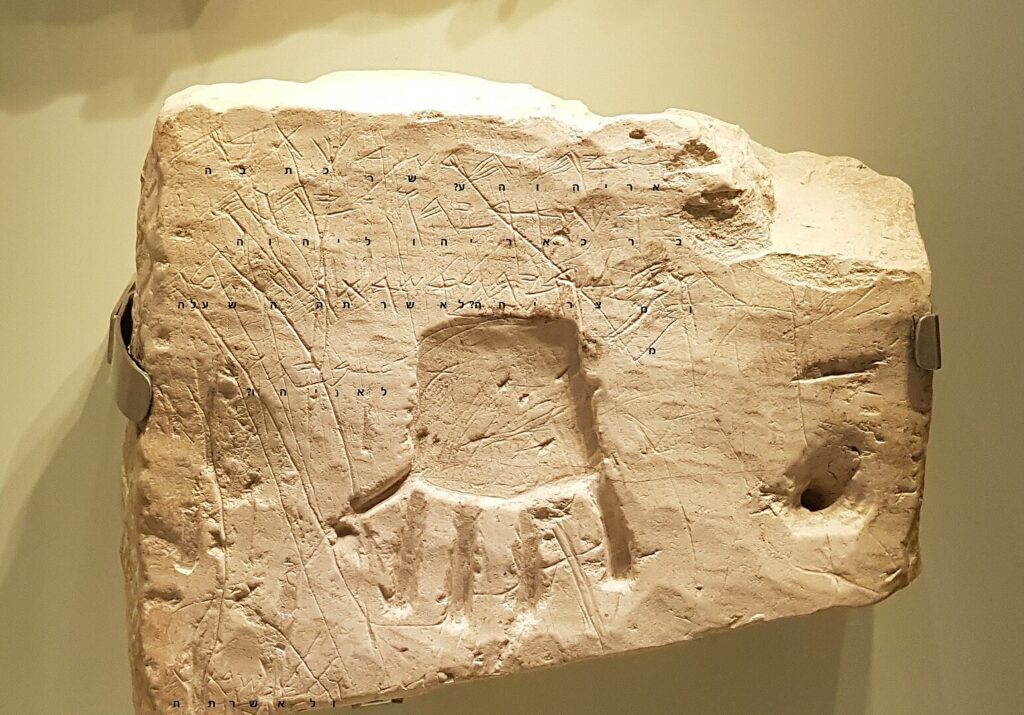Location
Khirbet el-Qom is situated 20 km west of Hebron, at the juncture of the Shephelah and the foothills of the central ridge, near Nalḥal Lachish. It is located in a strategic position that connects various geographical regions.


Identification
The site has been identified with several historical locations:
- Saphir of Micah 1:11, based on the Arabic name of the nearby Wadi es-Saffar.
- Makkedah of Joshua 10 and Eusebius’ Onomasticon, proposed by D. A. Dorsey, suggesting it as the inner fortress of the Lachish trough.
- Part of the third district of the Judean Shephelah, as reflected in Joshua 15.
History
Iron Age
- Judean Influence: The site’s history during the Iron Age is marked by Judean influence. This is evidenced by the remnants of an offset-inset cyclopean city wall and various artifacts from the tenth to seventh centuries BCE..
Hellenistic Period
- Cultural Transition: During the Hellenistic period, the site shows evidence of continued occupation and cultural transition. This is indicated by the discovery of Hellenistic rooms built over Iron Age II houses and various Hellenistic artifacts.
Biblical Context
The site’s biblical context is derived from its identification with locations mentioned in the Bible, such as Saphir, Makkedah, and the City of Salt. These identifications, while not definitive, provide a biblical framework for understanding the site’s historical significance.
Excavations
Excavations at Khirbet el-Qom began in 1967, led by the Archaeological Survey of Israel and the American archaeologist William Dever. Key findings include:
- Remnants of an offset-inset cyclopean city wall.
- Tenth-to-seventh-century BCE sherds, including a royal lamelekh jar handle.
- Eighth-to-seventh-century BCE Judean bench tombs.
- Inscribed pottery vessels and shekel weights.
- An inscription referring to “Uzza, son of Nethanyahu” or “Ophah, daughter of Nethanyahu.”
Findings
- Tombs: Elaborately laid out bench tombs with inscriptions, including names like ‘Ophai, ‘Uzza, and Uriyahu.
- Inscriptions: These inscriptions provide insights into the religious beliefs and practices of the time, including references to Yahweh and possibly Asherah.
- Pottery and Artifacts: Collections of pottery from various periods, including the Early Bronze Age, Middle Bronze Age, and the Hellenistic period.
The Hebrew inscription
One of the most notable finds from Khirbet el-Qom is a limestone slab with an inscription written in Hebrew. The inscription is a prayer to the god Yahweh, and it is one of the earliest known examples of a Hebrew inscription. The inscription is significant because it provides us with a rare glimpse into the religious beliefs of the people of ancient Israel.



The inscription reads:
“Blessed be Uriyahu by Yahweh. For from his enemies by his (Yahweh’s) Asherah he saved him.”
The inscription is significant because it mentions the goddess Asherah. Asherah was a Canaanite goddess who was worshipped by the Israelites during the Iron Age. The mention of Asherah in the Khirbet el-Qom inscription suggests that the Israelites were still worshipping Canaanite gods during the Iron Age, even though they were supposed to be worshipping only Yahweh.
The inscription is also significant because it shows that the Israelites believed that Yahweh could protect them from their enemies. The inscription suggests that the Israelites believed that Yahweh was a powerful god who could help them to win wars and to defeat their enemies.
The Khirbet el-Qom inscription is an important archaeological find that provides us with a rare glimpse into the religious beliefs of the people of ancient Israel. The inscription suggests that the Israelites were still worshipping Canaanite gods during the Iron Age, even though they were supposed to be worshipping only Yahweh. The inscription also shows that the Israelites believed that Yahweh could protect them from their enemies.
Sources
Stern, Ephraim-New Encyclopedia of Archaeological Excavations in the Holy Land 4-Israel Exploration Society (1993)

